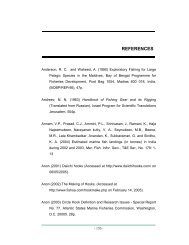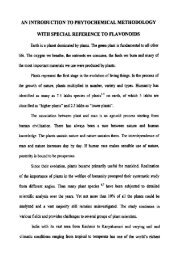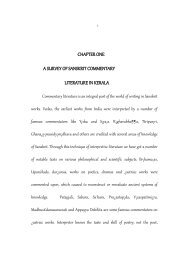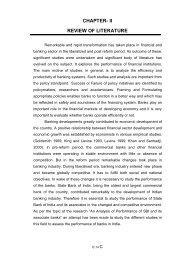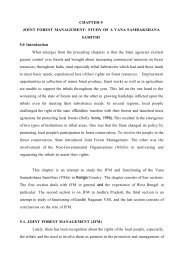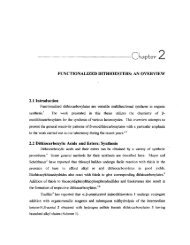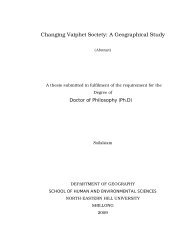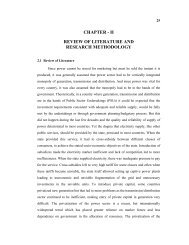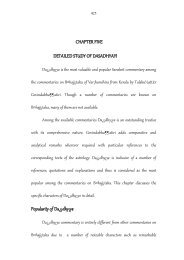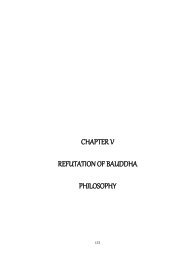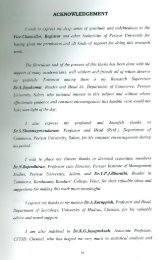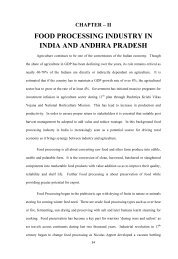CHAPTER I INTRODUCTION Cricket is basically a bat and ball ...
CHAPTER I INTRODUCTION Cricket is basically a bat and ball ...
CHAPTER I INTRODUCTION Cricket is basically a bat and ball ...
You also want an ePaper? Increase the reach of your titles
YUMPU automatically turns print PDFs into web optimized ePapers that Google loves.
<strong>CHAPTER</strong> I<br />
<strong>INTRODUCTION</strong><br />
<strong>Cricket</strong> <strong>is</strong> <strong>basically</strong> a <strong>bat</strong> <strong>and</strong> <strong>ball</strong> game played between two teams of eleven<br />
players. It <strong>is</strong> one of the oldest sports in the world <strong>and</strong> has its origin in 16 th century<br />
in Engl<strong>and</strong>. The expansion of the Brit<strong>is</strong>h Empire spread th<strong>is</strong> once colonial<br />
recreational sport into a spirited game to all corners. Today cricket seems to be a<br />
virtual lifeline of many commonwealth nations. <strong>Cricket</strong> <strong>is</strong> a game in which each<br />
team has to bowl <strong>and</strong> <strong>bat</strong> according to certain rules <strong>and</strong> regulations. A team<br />
which scores greater number of runs will be the winner.<br />
In olden days, the game was played in different names in different<br />
countries. The game of <strong>Cricket</strong> <strong>is</strong> developed from a simple game of hitting an<br />
object with a piece of wood. Basically it <strong>is</strong> the <strong>bat</strong>tle between <strong>bat</strong> <strong>and</strong> the <strong>ball</strong>,<br />
but the approach has changed from time to time. <strong>Cricket</strong> <strong>is</strong> played in many forms<br />
such as Test, One day International, First class Twenty 20, Super Six, Eight‐a‐side,<br />
Indoor <strong>Cricket</strong> Max <strong>Cricket</strong>, Double wicket <strong>and</strong> Single wicket. <strong>Cricket</strong> <strong>is</strong> played in<br />
more than 105 countries around the globe.<br />
The word “training” means different things in different fields. In sports the<br />
word “training” <strong>is</strong> generally understood to be synonym of doing exerc<strong>is</strong>e. In a<br />
narrow sense training <strong>is</strong> physical exerc<strong>is</strong>e for the improvement of performance.<br />
Training involves constructing an exerc<strong>is</strong>e programme to develop an athlete for a<br />
particular event. Th<strong>is</strong> increasing skill <strong>and</strong> energy capacities are equal<br />
consideration (Singh, 1991).
2<br />
Training <strong>is</strong> the main component <strong>and</strong> the basic form of preparing the athlete<br />
for higher level of performance. It <strong>is</strong> a systematically planned preparation with<br />
the help of the exerc<strong>is</strong>e which realizes the main factors of influencing athlete’s<br />
progress. The content of training includes all the basic types of preparation of the<br />
sportsmen such as physical, technical, tactical <strong>and</strong> psychological.<br />
SPORTS TRAINING<br />
Sports performance <strong>is</strong> complex mixture of genetic make‐up <strong>and</strong><br />
environment influences like training etc. Performance in cricket <strong>is</strong> determined by<br />
several factors namely skill, technique, tactics, fitness, training, etcetera. Training<br />
plays an important role in modern day <strong>Cricket</strong>. Harre et.al (1982) opine that<br />
Sports training <strong>is</strong> the physical, technical, intellectual, psychological <strong>and</strong> moral<br />
preparation of an athlete by means of physical exerc<strong>is</strong>e.<br />
The main aim of training <strong>is</strong> to prepare the <strong>Cricket</strong>ers for outst<strong>and</strong>ing<br />
performance in competition. Nowadays, technico‐tactical training has become<br />
very highly scientific <strong>and</strong> systematic. Physical fitness <strong>is</strong> the sum of numerous<br />
factors, which can vary from individual to individual.<br />
Different sports required different type of fitness emphasizing on a<br />
particular fitness factors. Similarly the training varies sports d<strong>is</strong>cipline to sports<br />
d<strong>is</strong>cipline. Field training <strong>is</strong> a highly co‐ordinate <strong>and</strong> well planned exerc<strong>is</strong>e.<br />
Generally in military th<strong>is</strong> type of training <strong>is</strong> very common. In modern sports<br />
training the game‐specific field training <strong>is</strong> gaining tremendous popularity, which<br />
focus on game‐specific fitness as well as performance related skill factors.
3<br />
PHYSICAL FITNESS AND CRICKET<br />
<strong>Cricket</strong> <strong>is</strong> a sport in which fitness <strong>is</strong> traditionally not thought of as very<br />
important. However, the success in the 1990s <strong>and</strong> 2000s of the world beating<br />
Australian team has been attributed to their professional<strong>is</strong>m, <strong>and</strong> in part to the<br />
way they address their fitness. The other test playing nations have rightfully put<br />
more emphas<strong>is</strong> on fitness recently <strong>and</strong> are reaping the benefits.<br />
With the introduction of one day <strong>Cricket</strong> <strong>and</strong> more recently Twenty20, the<br />
game has gone through major changes <strong>and</strong> the physical dem<strong>and</strong>s made on a<br />
<strong>Cricket</strong>er's body have also increased dramatically. Depending on the version of<br />
the game being played <strong>and</strong> the role of the player in the team, the importance of<br />
fitness will vary: the fitness requirements of a fast bowler will be greater <strong>and</strong> also<br />
different than that of an opening <strong>bat</strong>sman, <strong>and</strong> one‐day <strong>Cricket</strong> will be more<br />
dem<strong>and</strong>ing than a test match.<br />
Kapil Dev former Indian <strong>Cricket</strong> team captain <strong>and</strong> one of the best all<br />
rounder’s in the world of cricket started training at a very young age <strong>and</strong> he firmly<br />
believes that it <strong>is</strong> complete physical fitness that has contributed to h<strong>is</strong> overall<br />
success in all aspects of the game‐bowling, <strong>bat</strong>ting <strong>and</strong> fielding. He contends that<br />
physical fitness achieved during off‐season periods helped him in bowling long<br />
spells over <strong>and</strong> over again without fatigue or lapse of concentration. Kapil began<br />
h<strong>is</strong> test career in 1978. A truly remarkable accompl<strong>is</strong>hment! Even as a boy, he<br />
would go in for energetic jogging, springing <strong>and</strong> stretching exerc<strong>is</strong>es. Also he<br />
would bowl at the nets for as long as possible till the point of exhaustion<br />
(Amarnath, 1996).
4<br />
Bompa (1996) observe that, almost all physical activities incorporate one or<br />
more of the elements of force, quickness, duration <strong>and</strong> the range of motion.<br />
When a given exerc<strong>is</strong>e <strong>is</strong> required to overcome res<strong>is</strong>tance, it <strong>is</strong> called a strength<br />
exerc<strong>is</strong>e. When quickness <strong>and</strong> high frequency <strong>is</strong> maximized, it <strong>is</strong> referred to as a<br />
speed exerc<strong>is</strong>e. If d<strong>is</strong>tance, duration or the number of repetitions <strong>is</strong> high, an<br />
endurance exerc<strong>is</strong>e <strong>is</strong> performed. On the other h<strong>and</strong>, if the range of motion <strong>is</strong><br />
maximized, a flexibility movement <strong>is</strong> being performed. And finally, when in a<br />
given exerc<strong>is</strong>e a high degree of complexity <strong>is</strong> required, th<strong>is</strong> <strong>is</strong> known as coordination<br />
exerc<strong>is</strong>e.<br />
Buchanan (2010) former <strong>Cricket</strong> Australia national coach says that there are<br />
four major performance skills for all elite sportsmen <strong>and</strong> women, these being<br />
technical, physical, tactical <strong>and</strong> mental. The later skill <strong>is</strong> one that can make the<br />
crucial difference for athletes performing cons<strong>is</strong>tently to their abilities. Sport<br />
psychology has played a significant role in the underst<strong>and</strong>ing, training <strong>and</strong><br />
ultimately the use of mental skills for peak performance.<br />
Batsmen stay at the crease for as long as possible, sometimes for periods of<br />
over four hours. In order to occupy th<strong>is</strong> position, a good <strong>bat</strong>sman must be able to<br />
stay focused, have good <strong>ball</strong> / eye skills, <strong>and</strong> have the strength <strong>and</strong> fitness to<br />
make each played shot productive. On the other h<strong>and</strong>, power comes from having<br />
a strong core, abdominal mid‐section <strong>and</strong> the ability to generate explosive upper<br />
body actions. While on the other, the kinetic energy of the <strong>ball</strong> may be used to<br />
score four runs by the <strong>bat</strong>sman by a slight change in direction. Unfortunately th<strong>is</strong><br />
skill has only been given to a few class <strong>bat</strong>smen. Fielders need the ability to
5<br />
sustain a concentrated effort for a period of six hours or more without fatigue <strong>and</strong><br />
in sometimes very warm conditions. The body must be capable of explosive bursts<br />
at any given time ‐ such as racing for a <strong>ball</strong>, jumping for a catch. Every cricket<br />
player can contribute h<strong>is</strong> part to fielding unlike <strong>bat</strong>ting <strong>and</strong> bowling. In a tight<br />
game, fielding performance will invariably be the dec<strong>is</strong>ive factor between winning<br />
a match <strong>and</strong> losing it. (Muralikr<strong>is</strong>hnan, 2010)<br />
<strong>Cricket</strong>ers while progressing through different stages of their development<br />
should find fielding enjoyable rather than a tiresome chore. Fielding drills <strong>and</strong><br />
mechan<strong>is</strong>ms thereof are taught from a very young stage. Even in international<br />
cricket one could observe fielders picking up the <strong>ball</strong> with improper balance <strong>and</strong><br />
finding it difficult to make accurate throws to effect a run out. Learning to pick up<br />
the <strong>ball</strong> on either side will make the fielder confident to stop the <strong>ball</strong> <strong>and</strong> th<strong>is</strong><br />
makes the <strong>bat</strong>sman a little nervous to start for a run especially when the <strong>ball</strong> <strong>is</strong><br />
within the 30 yards circle. Fielding too <strong>is</strong> an important skill of the game. In recent<br />
times, more attention <strong>is</strong> being paid to fielding.<br />
The thrill that spectators get with a brilliant piece of fielding can seldom be<br />
matched by a huge six or the sight of the stumps sent flying by a quick bowler.<br />
Good fielders like Rhodes are always more popular than big hitters. Fielding <strong>is</strong> a<br />
regular part of every cricket game, big hitting may not always be seen in every<br />
match (Gavaskar, 2009).<br />
Bowlers require both explosive strength <strong>and</strong> speed, combined with good<br />
muscular endurance, in order to be able to maintain a high count of number of<br />
overs. Poor fitness <strong>and</strong> muscular strength will result in inaccurate bowling <strong>and</strong>
6<br />
greater r<strong>is</strong>k of injury, especially for high speed bowlers <strong>and</strong> also allows the<br />
<strong>bat</strong>smen to settle down in the wicket to score more runs. All players will at some<br />
time in the game, <strong>bat</strong> <strong>and</strong> field. A cricket training programme shall be designed<br />
with these as objectives in the mind.<br />
Flexibility <strong>is</strong> very important for a fast bowler. Denn<strong>is</strong> Lillee (1984) says<br />
"Flexibility <strong>is</strong> designed to give the bowler full freedom of movement when<br />
bowling a full speed, without threatening damage to h<strong>is</strong> muscle".<br />
In <strong>Cricket</strong>, we find an excellent integration of these physical attributes in<br />
different actions executed by <strong>bat</strong>smen, wicket keepers <strong>and</strong> fielders. In general,<br />
strength <strong>is</strong> required when executing a powerful hit out of the ground or to bowl a<br />
bouncer; speed <strong>is</strong> required to take a quick single, to stop a <strong>ball</strong> before it crosses<br />
the boundary line; flexibility <strong>is</strong> shown by an acro<strong>bat</strong>ic fielder; a square drive, a<br />
square cut speeding through the cordon of fielders shows a high degree of coordination<br />
<strong>and</strong> a pace bowler bowling through the entire session shows ample<br />
evidence of endurance. Even a single stroke executed by a master <strong>bat</strong>sman shows<br />
an excellent combination of all these character<strong>is</strong>tics, when, to a casual observer<br />
what was apparent was only good timing. Let us take an example of a wellexecuted<br />
cover drive. As a bowler runs in, the <strong>bat</strong>sman has to concentrate &<br />
watch <strong>and</strong> then in a split second he lunges forward showing speed <strong>and</strong> flexibility<br />
times the <strong>ball</strong> well, showing strength <strong>and</strong> co‐ordination. If he sees a chance to<br />
take a quick single, he speeds off to take one, <strong>and</strong> he does th<strong>is</strong>, <strong>ball</strong> after <strong>ball</strong><br />
showing stamina. (Sharangapani, 1992)
7<br />
The game <strong>is</strong> spread over five days (in tests) <strong>and</strong> the result <strong>is</strong> often<br />
dependent on what happens on the fifth day. An opening <strong>bat</strong>sman, wicketkeeper,<br />
fast bowler <strong>and</strong> an all‐rounder need ample endurance. A player who gets<br />
breathless after taking two runs cannot have a proper co‐ordination or strength<br />
to execute a good stroke when facing the next <strong>ball</strong>. A bowler who <strong>is</strong> breathless<br />
after bowling three <strong>ball</strong>s loses h<strong>is</strong> line <strong>and</strong> length for the next three. Developing<br />
these attributes <strong>is</strong> different for different muscle groups, as also for different<br />
individuals in respect of the individual requirement. Even though a training<br />
schedule tends to be generally uniform, it has to be individualized taking into<br />
consideration the need for it.<br />
Running, jumping, throwing are referred to as the fundamentals of natural<br />
human locomotion (Romanov, 2008). An essential element of successful cricket<br />
performance <strong>is</strong> the ability to accelerate, change direction quickly <strong>and</strong> move one’s<br />
feet quickly while at the crease. Th<strong>is</strong> requires development of speed <strong>and</strong> agility.<br />
A <strong>Cricket</strong>er needs static <strong>and</strong> dynamic strength in an altogether different<br />
way. In <strong>Cricket</strong>, one does not need such strength but proper development of<br />
strength <strong>is</strong> very important. (Sharangapani, 1992)<br />
Tendulkar stressed the importance of physical fitness <strong>and</strong> mental<br />
toughness which has helped him to have a prolonged successful career in<br />
International <strong>Cricket</strong>. "Physical fitness helps you in being mentally tough,<br />
enhancing you confidence level," the 37‐year‐old said.
8<br />
SPORTS PHYSIOLOGY AND CRICKET PERFORMANCE<br />
When physical training <strong>is</strong> done, the physiological changes occur in almost<br />
every system of the human body. These changes depend on frequency, duration<br />
<strong>and</strong> intensity. Sports Physiology tells about the complete story of various internal<br />
functions of the body during rest <strong>and</strong> play.<br />
Traditionally, <strong>Cricket</strong> has been perceived as a relatively mild sport from a<br />
physiological point of view. The intermittent nature of the game with its long rest<br />
intervals provides plenty of recovery time between any short spells of higher<br />
intensity activity. However, the dem<strong>and</strong>s of cricket may be underestimated<br />
(Noakes & Dur<strong>and</strong>t, 2000).<br />
High level of performance of a <strong>Cricket</strong>er might be dependent upon h<strong>is</strong><br />
physiological make up <strong>and</strong> it <strong>is</strong> recognized that physiological fitness <strong>is</strong> much<br />
needed for high level performance. It has numerous parameters such as aerobic<br />
capacity, anaerobic capacity, pulse, vital capacity, blood pressure, breath holding<br />
time <strong>and</strong> etcetera. Certain physiological variables play important role in <strong>Cricket</strong>.<br />
Most of physiological variables can be tested only in laboratory. Foster et.al<br />
(1986) opines that fast bowling <strong>is</strong> predominantly an anaerobic activity which<br />
requires an aerobic base. In one study of the 1999 South African World Cup side,<br />
a number of physiological tests for explosive power <strong>and</strong> aerobic endurance<br />
capacity showed they were as 'fit' as the South African national rugby side.
9<br />
SPORT PSYCHOLOGY AND CRICKET PERFORMANCE<br />
Cox et.al (1993) defines Sports Psychology as the Science of applying<br />
psychology to sports. It <strong>is</strong> a study of behavioral science in sports setting. Sports<br />
psychology <strong>is</strong> gradually <strong>and</strong> steadily gaining momentum in the field of training of<br />
high level sportspersons. Today, sport <strong>is</strong> no more a recreation. It <strong>is</strong> not just a<br />
game of nerves as well. With the winning margin of competitive sport narrowing<br />
down to fraction of seconds, modern day sport warrants an essential supply of<br />
psychological support to come to term with reality.<br />
Tendulkar, a current Indian <strong>Cricket</strong>er, who holds the record of most number<br />
of runs both Test <strong>and</strong> One day International <strong>Cricket</strong>, In press conference (2010) he<br />
said, "When pressure builds up in the game I try to focus on the next <strong>ball</strong> with<br />
calmness without thinking of the future course of the match. My mood undergoes<br />
a change before every match as I start mentally preparing myself for the game,"<br />
he added.<br />
Weinberg et.al. (1995) wrote that in any sport, a player’s success or failure<br />
results from a combination of physical <strong>and</strong> mental abilities. Most coaches<br />
consider that sport <strong>is</strong> atleast fifty percent mental, with certain sports such as golf,<br />
tenn<strong>is</strong> <strong>and</strong> figure skating, cons<strong>is</strong>tently receiving percentages in the 80 percent to<br />
90 percent range. According to Smith (1994), a former Engl<strong>is</strong>h <strong>Cricket</strong>er, “<strong>Cricket</strong><br />
<strong>is</strong> played in the mind, more than any other game”.<br />
Anxiety <strong>and</strong> Self confidence also play important role in <strong>Cricket</strong>. Anxiety <strong>is</strong> a<br />
negative emotional state with feelings of nervousness, worry <strong>and</strong> apprehension<br />
associated with activation or arousal of the body. (Weingberg <strong>and</strong> Gould, 1995).
10<br />
Anxiety depending upon the degree <strong>is</strong> defined indifferent ways such as tension,<br />
panic, etcetera.<br />
Self confidence <strong>is</strong> being confident of one’s own abilities. In other words, it<br />
<strong>is</strong> the <strong>Cricket</strong>er who real<strong>is</strong>tically believes that he <strong>is</strong> capable of performing well.<br />
Gould, We<strong>is</strong>s & Weinberg, (1981) opine that the most cons<strong>is</strong>tent factor<br />
d<strong>is</strong>tingu<strong>is</strong>hing highly successful from less successful athlete <strong>is</strong> ‘confidence’ Th<strong>is</strong><br />
means that top athletes, regardless of the sport, cons<strong>is</strong>tently d<strong>is</strong>play a strong<br />
belief in themselves <strong>and</strong> their abilities.<br />
Preponderance of scientific evidence obtained from different investigations<br />
has revealed that apart from physical <strong>and</strong> physiological variables, techniques <strong>and</strong><br />
tactics, high level performance of a sportsman <strong>is</strong> dependent upon h<strong>is</strong><br />
psychological makeup. Different psychic abilities play dec<strong>is</strong>ive roles in achieving<br />
top level performance in track <strong>and</strong> field athletics. Therefore superb psychological<br />
fitness <strong>and</strong> training of the “individual” are important factors, which help in<br />
achieving outst<strong>and</strong>ing performance (Manicam,2009)<br />
The concept of Anxiety occupies a very important place in the study of<br />
human personality <strong>and</strong> multitude activities of the mind. Trends were the first to<br />
define Anxiety within the context of Psychological theory. According to him,<br />
“Anxiety <strong>is</strong> something felt unpleasant effect of state or Condition”. Spielberger<br />
(1966), had defined Anxiety in different angles. These definitions lead to the<br />
conceptualization of ‘Anxiety’ as “a combination of apprehension, uncertainty <strong>and</strong><br />
fear”. Many studies of the past reveal that anxiety plays influential role in <strong>Cricket</strong>.<br />
Success in sports depends on trust in your own strength <strong>and</strong> ability. If an<br />
athlete <strong>is</strong> well prepared for competition from a physical, technical <strong>and</strong> tactical
11<br />
point of view, the most important factor deciding about h<strong>is</strong>/her degree of success<br />
<strong>is</strong> Self‐Confidence. Self‐Confidence <strong>is</strong> considered to be one of the leading<br />
elements for a successful athlete. Believe in one’s self <strong>is</strong> the centre of sports<br />
performance. One of the most important factors determining Self‐Confidence<br />
involves trust in our ability to execute a task. Like any other sport, in <strong>Cricket</strong> also<br />
self‐confidence as well as Sports Achievement Motivation plays critical role.<br />
YOGA<br />
Yoga <strong>is</strong> the oldest known science of self‐development, originated in ancient<br />
India. Yogic practice <strong>is</strong> a physical <strong>and</strong> mental exerc<strong>is</strong>es practiced throughout the<br />
world. Many research studies of the past report that yogic training improves the<br />
physical & mental fitness level as well as the performance of sports persons in<br />
various sports d<strong>is</strong>ciplines.<br />
Yoga <strong>is</strong> an ancient physical <strong>and</strong> spiritual d<strong>is</strong>cipline <strong>and</strong> branch of philosophy<br />
that originated in India reportedly more than 5,000 years ago. The word yoga<br />
comes from the Sanskrit word yuj, which means to yoke, join, or unite. The<br />
Iyengar School of yoga defines yuj as the "joining or integrating of all aspects of<br />
the individual—body with mind <strong>and</strong> mind with soul—to achieve a happy,<br />
balanced <strong>and</strong> useful life." The ultimate aim of yoga, they claim, <strong>is</strong> to reach<br />
kaivalya (emancipation or ultimate freedom).
12<br />
Samadhi<br />
(Vertical<br />
Mediation)<br />
Dhyana<br />
(Contemplation)<br />
Dharana<br />
(Concentration)<br />
Pratyahara<br />
(Sense Control)<br />
Pranayama<br />
(Breath control)<br />
Asana<br />
(Posture)<br />
Niyama<br />
(Self purifciation <strong>and</strong> study)<br />
Yama<br />
(Moral codes)<br />
Sri Aurobindo says “Yoga helps us to become conscious of the great<br />
complexity of our nature <strong>and</strong> the different forces that make it”<br />
There <strong>is</strong> no written record of the inventor of yoga. It was practiced by yog<strong>is</strong><br />
(yoga practitioners) long before humans knew how to write. Yog<strong>is</strong> over the<br />
millennia passed down the d<strong>is</strong>cipline to their students, <strong>and</strong> many different<br />
schools of yoga developed as it spread. The earliest written record of yoga, <strong>and</strong>
13<br />
one of the oldest texts in ex<strong>is</strong>tence, <strong>is</strong> generally believed to be written by<br />
Patanjali, an Indian yogic sage who lived somewhere between 2,000 <strong>and</strong> 2,500<br />
years ago. Patanjali <strong>is</strong> credited with writing the Yoga Sutras (sutra means "thread"<br />
in Sanskrit), which are the principles, philosophy, <strong>and</strong> practices of yoga that are<br />
still followed today. Although many schools of yoga have evolved over the<br />
centuries, they all follow the fundamental principles described by Patanjali more<br />
than 2,000 years ago. Buddh<strong>is</strong>m <strong>and</strong> other Eastern spiritual traditions use many of<br />
the yoga techniques or derivations of those techniques.<br />
After the Bhagavad Gita, the next seminal work on Yoga <strong>is</strong> the Yoga Sutras<br />
of Patanjali. The Yoga Sutras are a compilation of Yogic thought that <strong>is</strong> largely<br />
Raja Yogic in nature, it was codified sometime between the 2nd century BC <strong>and</strong><br />
the 3rd century by Patajali, <strong>and</strong> prescribes adherence to "eight limbs" (the sum of<br />
which constitute "Ashtanga Yoga") to quiet one's mind <strong>and</strong> merge with the<br />
infinite.<br />
Yoga for Complete Physical Fitness<br />
It would be an interesting fact for you that, people who carry out yoga<br />
regularly, can markedly grow up taller <strong>and</strong> it <strong>is</strong> because of the truth that they<br />
can hold themselves well <strong>and</strong> their vertebrae stretches. There are innumerable<br />
benefits which people get from yoga <strong>and</strong> because of th<strong>is</strong> reason yoga has<br />
become one of the fastest growing activities of the world. Yoga, in reality,<br />
creates balance in the mind as well as in the body. It helps in developing<br />
flexibility <strong>and</strong> strength. Different poses or asanas of yoga has different physical
14<br />
<strong>and</strong> mental benefits. There are numerous of aasans of yoga <strong>and</strong> each gives<br />
amazing benefits to the people.<br />
<br />
<br />
<br />
<br />
<br />
Yoga can make you more flexible, robust, <strong>and</strong> stronger. Due to the<br />
techniques used for breathing in yoga, all your joints get movement in full<br />
range. You will not feel painful when you get awake in the morning. Yoga<br />
will completely rejuvenate you.<br />
Yoga can help you to improve your posture. It can not only realign your body<br />
but it can help you even to grow taller.<br />
Yoga can improve your looks <strong>and</strong> makes you feel fit <strong>and</strong> fine. Your muscles<br />
will become firm <strong>and</strong> your complexion will grow up.<br />
You can d<strong>is</strong>cover much more about your body <strong>and</strong> its functions with the<br />
help of yoga. You can underst<strong>and</strong> that how yours conscious <strong>and</strong> unconscious<br />
mind affects your body. As more you will practice yoga you will d<strong>is</strong>cover<br />
more insight.<br />
If you have sleep d<strong>is</strong>orders then yoga can prove to be very beneficial. Yoga <strong>is</strong><br />
a soothing activity. It makes your muscles relaxed. Various kinds of sleeping<br />
d<strong>is</strong>orders can be cured by practicing yoga regularly.<br />
The various Yogic practices maybe classified into:<br />
1. Asanas<br />
2. Pranayamas<br />
3. Meditation
15<br />
1. Asanas<br />
These are special patterns of postures that stabilize the mind <strong>and</strong> the body<br />
through stretching. Their aim <strong>is</strong> to establ<strong>is</strong>h the proper rhythm in the<br />
neuromuscular tonic impulses <strong>and</strong> improve the general muscle tone.<br />
2. Pranayamas<br />
These practices bring control over the respiratory impulses which one of<br />
the channels of the follow of autonomic nerve impulses. The main purpose of<br />
Pranayama <strong>is</strong> to gain control over the autonomic nerve system <strong>and</strong> through it<br />
influence the mental function.<br />
3. Meditation<br />
Meditation <strong>is</strong> the practice involving control of the mental function which<br />
starts from the initial withdrawal of the senses from external objects to the<br />
complete oblivious of the external environment.<br />
Meditation <strong>is</strong> a great tranquill<strong>is</strong>er. The basic principle of meditation <strong>is</strong> to<br />
develop internal awareness.<br />
The nature of all Yogic practice <strong>is</strong> Psycho physiological. Some practices<br />
which emphasize on the direct control of mental process are more psychological<br />
other practices are more physical or psychological.
16<br />
Yoga for the promotion of sports<br />
Application of Yogic Exerc<strong>is</strong>e has considerable scope in the promotion of<br />
sports. Promotion of sports depends on<br />
1. Basic fitness factors<br />
2. Specific sports skill <strong>and</strong><br />
3. Psychological factors<br />
1. Promotion of Basic fitness factors through Yoga<br />
Excellent performance in any sports <strong>is</strong> governed by several factors of<br />
physical fitness. The important one may be mentioned as speed, strength,<br />
stamina, suppleness, stability <strong>and</strong> neuromuscular co‐ordination. Although not<br />
many scientific researchers have been done, the works of Herbet A.devries<br />
(1961a,1961b, 1962), Gharote (1964,1976), Dhanaraj (1974), Giri (1966), Gharote<br />
<strong>and</strong> Ganguly (1976) have shown enough evidence about how yoga could be gain<br />
fully employed in the promotion of basic fitness factors. Using elaborate<br />
Fle<strong>is</strong>hman Battery basic fitness test, Gharote (1974) has shown how even short<br />
term Yogic training could improve different basic fitness factors.<br />
2. Promotion of specific sports skills<br />
Development of sports skills depend on the proper neuromuscular<br />
coordination. Th<strong>is</strong> co‐ordination seems to be better the yogic exerc<strong>is</strong>e. Stretching<br />
improves the performance of all sports. It has now become almost customary to<br />
say: If you stretch your muscles, you can run faster.
17<br />
3. Promotion of Psychological factors<br />
Emotional factor <strong>is</strong> very important in the performance of sports. If rightly<br />
used emotion can contribute to the improvement of the performance in sports.<br />
Emotions are governed by working of autonomic nervous system. Control over<br />
the autonomic nervous system brings the emotional d<strong>is</strong>turbance down. Yogic<br />
exerc<strong>is</strong>es as a group pay a significant role in training of the autonomic nervous<br />
system. Stretching exerc<strong>is</strong>e like Asanas, relaxation techniques <strong>and</strong> breathing<br />
exerc<strong>is</strong>e in the form of Pranayama are excellent in conditioning the autonomic<br />
nervous system. A few studies made on the effects of short‐term Yogic routine<br />
have shown the utility of Yoga in the achievement of emotional stability.<br />
Maintenance of physical fitness during participation period <strong>and</strong> in off<br />
season. Physical fitness <strong>is</strong> must for any good performance in sports. Different<br />
sports require different type of fitness emphasizing on a particular fitness factor.<br />
However, general level of physical fitness <strong>is</strong> necessary for every sportsman. The<br />
law of use <strong>and</strong> d<strong>is</strong>use that if you want to be fit you must exerc<strong>is</strong>e. The routine of<br />
exerc<strong>is</strong>e differ from individual to individual according to purpose. Sportsmen also<br />
select different routines of exerc<strong>is</strong>e during the season of participation.<br />
CONTRIBUTION OF YOGIC EXERCISES IN THE FIELD OF SPORTS<br />
Yoga can be practiced by males <strong>and</strong> females of all ages <strong>and</strong> it can be taken<br />
up at any stage of life. It <strong>is</strong> never too late to begin. Through yoga one can achieve<br />
the success of life. It <strong>is</strong> the fact that yoga plays an important role for reducing<br />
stress, tension <strong>and</strong> anxiety of common man as well as of athletes. . Mainly the
18<br />
stress <strong>and</strong> anxiety play an important role in sports, as these are an integral part of<br />
the "motivation for peak performance" in a sports activity. In recent competitive<br />
situation, impose tremendous stress <strong>and</strong> tensions on sportsman while aiming of<br />
winning a medal. The high level of sports anxiety d<strong>is</strong>turbs body awareness <strong>and</strong><br />
affect physiological functions which res<strong>is</strong>t the smooth movement of muscles,<br />
joints etc. Different type of yogic exerc<strong>is</strong>es increase the flexibility of back, spine,<br />
hip, improve the concentration <strong>and</strong> balancing ability, improve the efficiency of<br />
liver <strong>and</strong> digestive system, cure the neuros<strong>is</strong> <strong>and</strong> cardiac d<strong>is</strong>eases, remove the<br />
blood pressure problems, strengthen the back <strong>and</strong> shoulder muscles, improve<br />
breath <strong>and</strong> release the mental tension <strong>and</strong> centering emotions of the sportsmen,<br />
which are the main essentials related to the performance of the athletes in<br />
different games <strong>and</strong> sports. of immense use in improving the sense of aesthetics<br />
in sports. However, till‐to‐date neither any information nor research report on<br />
yoga in relation to aesthetics in sports <strong>is</strong> available so far. It was, therefore through<br />
desirable to see if yoga can contribute to enhance the aesthetic aspects so that an<br />
athlete improves case in movements <strong>and</strong> skill for performance. Yoga can be<br />
practiced by males <strong>and</strong> females of all ages <strong>and</strong> it can be taken up at any stage of<br />
life. It <strong>is</strong> never too late to begin. Through Yoga one can (Sharma, 2010)<br />
The vital role played by yoga i.e. physical fitness, fitness related to health,<br />
skill <strong>and</strong> performance has assumed tremendous importance in recent times. The<br />
life style changes leading to positive energy balances has been the causative<br />
factor for many of the metabolic d<strong>is</strong>orders like hypertension, diabetes malites,<br />
cardio vascular d<strong>is</strong>eases <strong>and</strong> obesity <strong>and</strong> related problems. Yoga, which <strong>is</strong> a timetested<br />
method, has shown great positive influence on physical, mental,
19<br />
psychological, social <strong>and</strong> spiritual personalities of a person. With the above in<br />
background various research works have been undertaken to measure the<br />
changes that take place during yoga practice.<br />
BENEFITS OF YOGA<br />
Yoga <strong>is</strong> a system that benefits body, mind <strong>and</strong> spirit by teaching self control<br />
through series of postures <strong>and</strong> exerc<strong>is</strong>es as well as through breathing <strong>and</strong><br />
relaxation <strong>and</strong> meditation techniques. The most important benefit of yoga <strong>is</strong><br />
physical <strong>and</strong> mental therapy. The aging process, which <strong>is</strong> largely an artificial<br />
condition, caused mainly by autointoxication or self‐po<strong>is</strong>oning, can be slowed<br />
down by practicing yoga. By keeping the body clean, flexible <strong>and</strong> well lubricated,<br />
we can significantly reduce the catabolic process of cell deterioration. To get the<br />
maximum benefits of yoga one has to combine the practices of yogasanas,<br />
pranayama <strong>and</strong> meditation.<br />
1. Yoga works for the entire body<br />
In sports such as Foot<strong>ball</strong>, hockey, or tenn<strong>is</strong>, one tends to utilize only 10 to<br />
15 per cent of the body, whereas yoga provides a workout that covers every<br />
muscle, joint <strong>and</strong> organ.<br />
2. Yoga works for every size<br />
It does not matter how one look when practice yoga. Whether you're a<br />
250‐pound linebacker or a 150‐pound triathlete, yoga will push one’s personal<br />
boundaries by increasing your own flexibility, endurance <strong>and</strong> muscle strength
20<br />
3. Yoga decreases muscle soreness<br />
Yoga <strong>is</strong> hugely beneficial in working out stiffness from other sports. When<br />
muscles are fatigued, they build with lactic acid, <strong>and</strong> yoga, which stretches <strong>and</strong><br />
releases tension, helps flush that away. Runners in particular find yoga the best<br />
activity after a long endurance jog.<br />
4. Yoga restores energy levels<br />
Yoga practice doesn't deplete energy completely, like a gym workout,<br />
where one’s body <strong>is</strong> entirely tired after the session. Instead, it actually increases<br />
the vigor, making to feel more aware <strong>and</strong> revitalized.<br />
5. Yoga balances the mind<br />
Yoga has such a great sense of community to it <strong>and</strong> it really allows for<br />
mental clarity <strong>and</strong> focus. After the yoga practice, one can feel more grounded,<br />
less self‐absorbed <strong>and</strong> peaceful. Th<strong>is</strong> type of mental clarity really helps in other<br />
sports or activities involved in. (Ceroni, 2009)<br />
Yoga places a huge emphas<strong>is</strong> on balance, flexibility, <strong>and</strong> mental d<strong>is</strong>cipline,<br />
traits essential for a sport like soccer too. Simple yoga exerc<strong>is</strong>es are a great way to<br />
warm up before soccer practice or loosen up after a game. The incidence of<br />
injuries can also be reduced if one practice yoga as it also sharpens reflexes.<br />
Specific exerc<strong>is</strong>es include poses like the spread‐leg forward fold or<br />
‘Upav<strong>is</strong>ta Konasana’. In th<strong>is</strong> pose, players sit on the floor with your legs parted as<br />
wide as possible. Then lean forward <strong>and</strong> place h<strong>and</strong>s on the floor. Maintain th<strong>is</strong>
21<br />
stretch for 15 seconds <strong>and</strong> r<strong>is</strong>e back up. Repeat th<strong>is</strong> about 10‐15 times. With th<strong>is</strong><br />
posture, the hamstrings <strong>and</strong> calf muscles are stretched making them more<br />
flexible. Th<strong>is</strong> <strong>is</strong> a good yoga pose to begin soccer practice with.<br />
In order to provide the necessary power to legs back muscles need to be<br />
strong. The dog pose or the Adho Mukha Svanasana <strong>is</strong> useful for th<strong>is</strong>. To do th<strong>is</strong><br />
pose, sit on the floor on all fours. After th<strong>is</strong>, gently lift up hips alone while keeping<br />
legs <strong>and</strong> h<strong>and</strong>s completely stretched out. Make sure that back <strong>is</strong> fully straight.<br />
Return to the original pose <strong>and</strong> repeat th<strong>is</strong> 10‐15 times as well. Th<strong>is</strong> exerc<strong>is</strong>e<br />
strengthens back muscles of the players.<br />
A good exerc<strong>is</strong>e to fin<strong>is</strong>h cricket practice with <strong>is</strong> the hero pose or ‘Virasana’.<br />
Th<strong>is</strong> <strong>is</strong> a simple pose where player need to kneel down with feet pointing<br />
backwards. Keep back straight <strong>and</strong> take in deep breaths. Th<strong>is</strong> pose will loosen<br />
hips, knees <strong>and</strong> ankles <strong>and</strong> relax joints after a tiring workout.<br />
<strong>Cricket</strong> players can also practice breathing techniques like ‘Ujjayi’ breathing<br />
to help to be calm. For th<strong>is</strong> exerc<strong>is</strong>e, take in full deep breaths through both<br />
nostrils for at least 10 minutes. Th<strong>is</strong> will increase breath‐holding time <strong>and</strong><br />
strengthen lungs thus increasing endurance levels.<br />
So we've all heard that many pros practice yoga for sports training. But who<br />
exactly does yoga benefit the most Does it work better for some sports rather<br />
than others I was quite curious to find out, so I did a little bit of research <strong>and</strong><br />
found a very impressive (<strong>and</strong> diverse) l<strong>is</strong>t of famous professional athletes who<br />
practice yoga to improve their game performance. In no particular order:
22<br />
1. Le Bron James. Perhaps the most well‐known player in the NBA, Le Bron<br />
attributes h<strong>is</strong> good health to h<strong>is</strong> regular yoga practice.<br />
2. Maria Sharapova. Famous for her grace <strong>and</strong> performance in tenn<strong>is</strong>, she says:"<br />
When I travel to tournaments I put the d<strong>is</strong>k in my computer three or four<br />
times a week <strong>and</strong> do yoga for about an hour. It helps my flexibility <strong>and</strong> gets me<br />
more relaxed, especially after a good workout. I enjoy it, <strong>and</strong> it helps my game<br />
tremendously."<br />
3. The entire Philadelphia Eagles NFL team. The famous Baron Bapt<strong>is</strong>te yoga<br />
guru led the team through their yoga for sports training for four years!<br />
4. Tim Thomas. The Boston Bruins <strong>and</strong> US Olympic goaltender says he "had no<br />
idea what [he] was getting [himself] into" <strong>and</strong> he was sweating within 5<br />
minutes."My whole career has been about proving to people that I can play in<br />
the NHL <strong>and</strong> that I can be very successful in the NHL so yoga's part of that<br />
journey."<br />
5. Ex‐Laker Kareem Abdul‐Jabar. He has been quoted saying "There <strong>is</strong> no way I<br />
could have played as long as I did without yoga."<br />
6. Daylan Childress, Cincinnati Reds Pitcher. Th<strong>is</strong> base<strong>ball</strong> player uses yoga to<br />
relieve stresses in h<strong>is</strong> body <strong>and</strong> cure back pain.<br />
7. The Ottawa Senators NHL team. They reported that the fewer injuries in the<br />
2006‐07 seasons were the fruit of their yoga training.<br />
8. Shaquille O'Neal.<br />
Wow! What a diverse group of well‐known professional athletes! In th<strong>is</strong> l<strong>is</strong>t,<br />
we have got basket<strong>ball</strong>, tenn<strong>is</strong>, foot<strong>ball</strong>, hockey, <strong>and</strong> base<strong>ball</strong> players who all
23<br />
use yoga for sports training. I think it <strong>is</strong> safe to say that no matter what sport<br />
you are playing, you will benefit from practicing yoga.<br />
RATIONALE FOR SELECTING THE PROBLEM<br />
The investigator, being a <strong>Cricket</strong>er, coach, selector, <strong>and</strong> Yogic practitioner<br />
was motivated to find out the impact of field training with <strong>and</strong> without yogic<br />
practice on selected physical, physiological, psychological <strong>and</strong> performance<br />
variables among the <strong>Cricket</strong> players. Moreover, very little research had been done<br />
on field training <strong>and</strong> yogic practice among <strong>Cricket</strong> players. Th<strong>is</strong> also motivated the<br />
investigator to take‐up the study.<br />
STATEMENT OF THE PROBLEM<br />
At present most of the <strong>Cricket</strong> players lack physical, physiological,<br />
psychological <strong>and</strong> performance components in terms of speed, strength,<br />
endurance <strong>and</strong> flexibility; resting heart rate, aerobic power, anaerobic power <strong>and</strong><br />
breath holding time; anxiety, self confidence <strong>and</strong> sports achievement motivation<br />
<strong>and</strong> <strong>Cricket</strong> playing ability which can be overcome by special exerc<strong>is</strong>es such as<br />
Asana, Pranayama <strong>and</strong> Meditation. Most of the researchers haven’t hitherto<br />
tread upon th<strong>is</strong> field. So the investigator attempts to take‐up th<strong>is</strong> problem.<br />
The purpose of th<strong>is</strong> study was to determine the impact of field training with<br />
<strong>and</strong> without yogic practice on selected physical, physiological, psychological <strong>and</strong><br />
performance variables among <strong>Cricket</strong> players.
24<br />
HYPOTHESES<br />
1. There would be a significant improvement on the selected physical,<br />
physiological, psychological <strong>and</strong> performance factors among <strong>Cricket</strong> players<br />
due to the influence of field training with <strong>and</strong> without yogic practice<br />
package.<br />
2. There would be a significant difference between the experimental groups<br />
on selected physical, physiological, psychological <strong>and</strong> performance factors<br />
after the training period.<br />
SIGNIFICANCE OF THE STUDY<br />
1. The study would help to explore the effectiveness of field training <strong>and</strong> yogic<br />
practice on selected physical, physiological, psychological <strong>and</strong> performance<br />
variables among <strong>Cricket</strong> players.<br />
2. The field training <strong>and</strong> yogic practice schedule designed in th<strong>is</strong> study would<br />
help the yoga experts, physical educators <strong>and</strong> coaches in designing these<br />
packages.<br />
3. The findings of the study would add to the quantum of knowledge in the<br />
area of Sports training <strong>and</strong> Yoga.<br />
DELIMITATIONS<br />
1. Forty eight male inter‐collegiate <strong>Cricket</strong> players studying in various colleges<br />
affiliated to Madurai Kamaraj University, Madurai, Tamilnadu state in India<br />
were r<strong>and</strong>omly selected as subjects their age ranges from 18 to 25 years.
25<br />
2. The subjects had past playing experience of at least three years in <strong>Cricket</strong><br />
<strong>and</strong> only those who represented their respective college teams were taken<br />
as subjects.<br />
3. By using the matching procedure on the bas<strong>is</strong> their initial test performance<br />
scores on <strong>Cricket</strong> playing ability, the subjects were divided into three equal<br />
groups in which each group cons<strong>is</strong>ted of sixteen subjects <strong>and</strong> named<br />
Group‐I was involved field training, Group‐II was given field training<br />
combined with yogic practice, Group‐III (Control group) was not exposed to<br />
any training/conditioning other than their daily routines activities.<br />
4. The experimental groups underwent field training for twelve weeks. In<br />
addition to the above field training, Group‐II had also undergone yogic<br />
practice package schedule.<br />
5. The selected variables for the present study are Physical fitness<br />
components namely speed, endurance, explosive strength <strong>and</strong> flexibility;<br />
Physiological variables namely resting heart rate, aerobic power, anaerobic<br />
power <strong>and</strong> breath holding time; Psychological variables namely competitive<br />
state anxiety, cognitive, somatic, self confidence <strong>and</strong> sports achievement<br />
motivation <strong>and</strong> performance was subjectively rated by three qualified<br />
<strong>Cricket</strong> coaches were only selected as variables.<br />
6. Only pre <strong>and</strong> post tests were taken. The following st<strong>and</strong>ardized tests were<br />
used to measure the Physical fitness components namely 50 metres run, 12<br />
minutes run, st<strong>and</strong>ing broad jump <strong>and</strong> sit & reach. Physiological factors<br />
was measured by st<strong>and</strong>ard protocol using Digital heart rate monitor,<br />
Astr<strong>and</strong>‐Astr<strong>and</strong> Nomogram (bench stepping), Margaria‐Kalamen power
26<br />
test <strong>and</strong> Digital Stop watch used to measure breath holding time.<br />
Psychological factors were measured by st<strong>and</strong>ard<strong>is</strong>ed questionnaire,<br />
namely Sports Competitive Anxiety Test (SCAT) developed by Martens<br />
(1990) <strong>and</strong> Competitive State Anxiety Questionnaire II (CSAI‐2) developed<br />
by Martens, Burton, Vealey, Bump <strong>and</strong> Smith (1990), Sports Achievement<br />
Motivation test Questionnaire developed by Kamlesh (1983). To measure<br />
the <strong>bat</strong>ting, bowling <strong>and</strong> fielding performance in <strong>Cricket</strong>, the subjectively<br />
rating by three qualified coaches was used to measure their performance in<br />
playing ability.<br />
LIMITATIONS<br />
1. The subjects selected for the study were non‐residential <strong>Cricket</strong> players<br />
with different economic background. Therefore, variations in their living<br />
conditions, life style <strong>and</strong> diet were recognized as a limitation of the study.<br />
2. The previous experience of the subjects in the field of <strong>Cricket</strong> which might<br />
be influencing on the training <strong>and</strong> data collection were not considered.<br />
3. The investigator did not take any effort to control or assess the quality <strong>and</strong><br />
quantity of food ingested separately by each individual.<br />
4. The quantum of physical exertion, physiological & psychological stress <strong>and</strong><br />
other factors that affect the results were also considered as limitations.<br />
5. The meteorological variations such as air, temperature, atmospheric<br />
pressure, relative humidity during the testing periods could not be<br />
controlled <strong>and</strong> their possible influence on the results of the study was<br />
recognized as a limitation.
27<br />
6. The responses to the subjects to the statements in the Questionnaire would<br />
depend upon various factors such as underst<strong>and</strong>ing of the statements,<br />
seriousness <strong>and</strong> sincerity of the subjects.<br />
DEFINITION OF TERMS<br />
FIELD TRAINING<br />
The physical training which was specially designed to improve the technicotactical<br />
part of the game <strong>and</strong> also the fitness components essential for <strong>Cricket</strong>ers.<br />
YOGIC PRACTICE PACKAGES<br />
Yogic practice package refers to a set of yogic techniques (asana,<br />
pranayama <strong>and</strong> meditation) that are completed sequentially (one exerc<strong>is</strong>e after<br />
another). Each exerc<strong>is</strong>e <strong>is</strong> performed: slow, relaxed, rhythmic <strong>and</strong> with total<br />
awareness for a specific period. The duration of the yogic exerc<strong>is</strong>e package<br />
training <strong>is</strong> 45 minutes.<br />
YOGA<br />
Pathanjali defined in h<strong>is</strong> second Pathanjali's aphor<strong>is</strong>m Yoga : Citta ‐ Vrtti ‐<br />
Nirodhah. Yoga <strong>is</strong> a process of gaining control over the mind. In Yoga – Vas<strong>is</strong>tha<br />
one of the best texts on yoga, the essence of yoga <strong>is</strong> beautifully portrayed thus<br />
'Manah Prasamanopayah Yoga if yabhidhi yate' ‐ yoga <strong>is</strong> called a skillful trick to<br />
calm down the mind. It <strong>is</strong> an (UP A YAH), a skillful subtle process <strong>and</strong> not a brutal,<br />
mechanical gross effort to stop the thoughts in the mind. (Nagarathna <strong>and</strong><br />
Nagendra, 2001).
28<br />
ASANA<br />
"Asana <strong>is</strong> a steady <strong>and</strong> comfortable posture of body". The word Asana<br />
comes from the Sanskrit root "Aas" meaning to sit. The two character<strong>is</strong>tics of<br />
Asana are 'stability' <strong>and</strong> 'comfort'. It practically answers all questions related to<br />
asana. So pathanjali defines 'asana' in h<strong>is</strong> yogasutras as "STHIRA SUKHAM<br />
ASSANAM".<br />
PRANAYMA<br />
"Pranayama means controlling the prana".<br />
Ch<strong>and</strong>rasekaran (1999) opined that Pranayama <strong>is</strong> an exerc<strong>is</strong>e that prolongs<br />
life. The word pranayama <strong>is</strong> derived from the Sanskrit root called 'Prana' <strong>and</strong><br />
'Ayama'. The syllable prana denotes the air that leaves from the body. Ayama has<br />
two meanings.<br />
(i)<br />
to elongate<br />
(ii) to withhold<br />
MEDITATION<br />
Overcoming the fluctuations <strong>is</strong> meditation. Meditation <strong>is</strong> the study of deep<br />
concentration, calmness <strong>and</strong> tranquility of the mind.<br />
SPEED<br />
Speed may be defined as the capacity of the individual to perform<br />
successive movements of the same pattern at a fast rate. (Yobu, 1988)
29<br />
STRENGTH<br />
Strength <strong>is</strong> the ability to overcome res<strong>is</strong>tance or to act against res<strong>is</strong>tance.<br />
(Singh, 1991)<br />
ENDURANCE<br />
Endurance <strong>is</strong> the capacity of a muscle to exert force repeatedly against<br />
some res<strong>is</strong>tance over a period of time. (Yobu, 1988)<br />
FLEXIBILITY<br />
It <strong>is</strong> defined as the range of possible movement about a joint or sequence<br />
of joints. (Clarke, 1978)<br />
EXPLOSIVE STRENGTH<br />
The ability to expend energy in one explosive act or in a series of strong,<br />
sudden movements as in jumping or projecting some object, as far as possible<br />
(kent, 1994).<br />
AEROBIC POWER<br />
Maximum rate at which an individual can consume oxygen during the<br />
performance of all‐out, exhaustive exerc<strong>is</strong>e, the “best” index of cardio respiratory<br />
fitness. (Kennet, 1996)
30<br />
ANAEROBIC POWER<br />
The maximum rate of energy released for muscle work. (Fox et.al., 1993)<br />
RESTING HEART RATE<br />
The heart rate beat or heat frequency <strong>is</strong> defined as the frequency of heart<br />
beats in one minute, when a player <strong>is</strong> in resting condition. (Geddie, 1964)<br />
BREATH HOLDING TIME<br />
Th<strong>is</strong> <strong>is</strong> the duration of voluntary holding of the breathing after the<br />
maximum inhaling. The holding of breath <strong>is</strong> performed for a maximum period,<br />
which an individual <strong>is</strong> able to withst<strong>and</strong>, without restoring to normal breathing.<br />
PSYCHOLOGY<br />
Psychology <strong>is</strong> defined as “the scientific study of behaviour <strong>and</strong> mental<br />
process” (Crider, 1989).<br />
SPORTS PSYCHOLOGY<br />
Sport psychology <strong>is</strong> the branch of sports <strong>and</strong> exerc<strong>is</strong>e science that seeks to<br />
provide answer to questions about human behaviour in sports.<br />
ANXIETY<br />
It <strong>is</strong> a negative emotional state with feelings of nervousness, worry <strong>and</strong><br />
apprehension associated with activation or arousal of the body (Weinberg, et.al.,<br />
1995).
31<br />
Anxiety <strong>is</strong> defined as a tense state of such severity. The work efficiency was<br />
interfaced with w<strong>and</strong> medical advice which <strong>is</strong> characterized by one or more of the<br />
following complaints. Pers<strong>is</strong>tent feelings of tension <strong>and</strong> strains, irritability,<br />
unremitting worry, restlessness, inability to concentrate, feelings of panic in<br />
everyday life situations.<br />
COGNITIVE ANXIETY<br />
“Cognitive anxiety <strong>is</strong> mental component of anxiety <strong>and</strong> <strong>is</strong> caused by<br />
negative self‐evaluation”.<br />
Cognitive anxiety <strong>is</strong> characterized by “conscious awareness of unpleasant<br />
feelings about oneself or external stimuli, worry, d<strong>is</strong>turbing v<strong>is</strong>ual images”. In<br />
sport, cognitive anxiety <strong>is</strong> most commonly manifested by negative performance<br />
expectations <strong>and</strong> thus negative self‐evaluation (Martens et al, 1990).<br />
SOMATIC ANXIETY<br />
“Somatic anxiety refers to the physiological <strong>and</strong> affective elements of the<br />
anxiety experience that develop directly from autonomic arousal. It <strong>is</strong> reflected in<br />
such responses as rapid heart rate, shortness of breath, clammy h<strong>and</strong>s, butterflies<br />
in the stomach, <strong>and</strong> tense muscles” (Martens et al, 1990).<br />
SELF CONFIDENCE<br />
Self‐confidence <strong>is</strong> the belief that one that aids an individual to perform any<br />
desired behaviour successfully (Weinberg <strong>and</strong> Gould, 1995).
32<br />
ACHIEVEMENT MOTIVATION<br />
Achievement motivation <strong>is</strong> dominant motivational orientation in situations<br />
character<strong>is</strong>t<strong>is</strong>ed by the attainment of clear success or failure. The two motives<br />
are either to achieve success (mass) or to avoid failure (Bird <strong>and</strong> Cripe, 1992).




